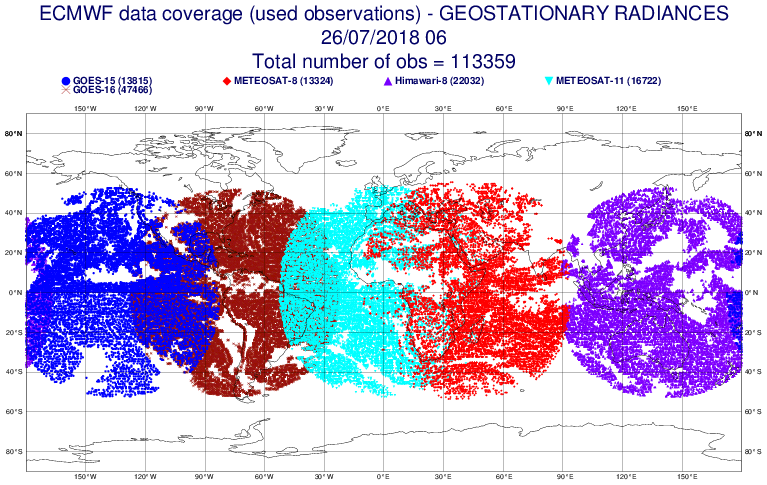
[ Archive ]

 |
CIMSS-NOAA Weekly Report [ Archive ] |
 |
ASPB AND CIMSS WEEKLY HIGHLIGHTS FOR THE WEEK ENDING JULY 27, 2018
IN THE PRESS:
ITEMS FOR THE ADMINISTRATOR:
ITEMS FOR THE ASSISTANT ADMINISTRATOR:
ITEMS FOR THE OFFICE DIRECTOR, STAR:
GOES-16 Provisional Maturity Review for Baseline Volcanic Ash Products: The Provisional Validation Maturity Review for the baseline GOES-16 volcanic ash products, which was held on 20 July 2018, was successfully completed. The baseline GOES-16 volcanic ash products are derived using an older algorithm developed over 10 years ago. Thus, the products are not representative of the latest capabilities, which users have become accustomed to via experimental data feeds. The review panel recommended that a plan for transitioning the latest capabilities, to operations, be drafted. Given this recommendation, it is not yet known if further validation of the baseline volcanic ash products will be conducted. Transitioning the latest capabilities to operations presents several challenges because of the multi-sensor nature of the processing and the inclusion of services such as eruption alerting. (M. Pavolonis, E/RA2, 608-263-9597, Mike.Pavolonis@noaa.gov)
2019 AMS Fellows Announced: The American Meteorological Society (AMS) recently announced the 2019 awardees, including fellows. Both Mitch Goldberg and Tim Schmit are in the class of new AMS Fellows. The complete list is at https://www.ametsoc.org/ams/index.cfm/about-ams/ams-awards-honors/2019-awards-and-honors-recipients/. (T. Schmit, E/RA2, 608-263-0291)
GOES-16 Clear Sky Radiances Used by ECMWF: The European Centre for Medium-Range Weather Forecasts (ECMWF) is now using Geostationary Operational Environmental Satellite (GOES)-16 Advanced Baseline Imager (ABI) Clear Sky Radiances. This fills the previous gap in coverage caused by the retirement of GOES-13. This application uses the GOES-R Baseline Cloud Mask developed at the Cooperative Institute for Meteorological Satellite Studies (CIMSS) and data formatting tools developed at STAR. CIMSS Scientists also played a key role in optimizing this data for this application This project was funded by GOES-R Risk Reduction. (A. Heidinger, E/RA2,andrew.heidinger@noaa.gov, Jim Jung, CIMSS, jim.jung@noaa.gov, Sharon Nebuda, CIMSS, sharon.nebuda@ssec.wisc.edu)
 (Click image to enlarge)
(Click image to enlarge)
Figure caption: ECMWF coverage map for the geostationary clear sky radiances. Figure from ECWMF.
ITEMS FOR THE DIVISION CHIEF, CoRP:
CIMSS Presentations at GOES-16 Training at UNAM in Mexico City: The Cooperative Institute for Meteorological Satellite Studies (CIMSS) participated in a NOAA Workshop on GOES-16/GOES-17 Data and Products from 23-25 July 2018 at UNAM (Mexico’s National University) in Mexico City. The Workshop was also sponsored by UNAM’s Institute of Geography, AEM (The Mexican Space Agency), CENAPRED (Mexico’s Disaster Management Agency) and INEGI (Mexico’s Statistical Institute). Scott Lindstrom from CIMSS gave presentations and answered questions on the Geostationary Lightning Mapper (GLM), the GOES-R Advanced Baseline Imager (ABI), Polar Orbiting Satellite Data Sources, Fire Detection using the GOES-16 ABI, and Water Vapor Imagery with ABI. The approximately 90 Mexican attendees included University Professors, Students, Government and Aviation Officials and Military. Participants also enjoyed a tour of LANOT (Laboratorio Nacional de Observación de la Tierre), a facility that has a GOES-16 Re-Broadcast (GRB) antenna, a Joint Polar Satellite System (JPSS) Direct Broadcast Antenna and a GeoNetCast-Americas antenna, which facility processes GOES-16 and Polar Orbiting data for the Mexico Meteorological Community. (Scott Lindstrom, CIMSS, 608 263 4425)
VISITORS:
NEXT WEEK:
LOOKING AHEAD:
| Archived Weeklies Page | Submit a report item |